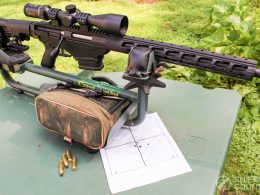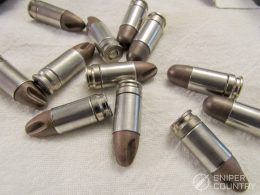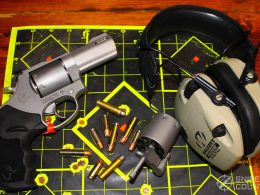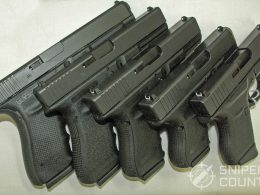In this Article:
If you’re a gun owner, you know there’s nothing like owning a 1911. They’re revered for their precision and craftsmanship, and the Kimber Custom II is no exception. It’s been around for years and has built a reputation for being reliable, accurate, and well-made.
In this review, we’ll look at why the Custom II is such a popular choice among shooters and gun enthusiasts. So read on to find out why this pistol might be the perfect fit for you.
BONUS OFFER: Get your free shooting range targets to print at home!
Get your free targets to print at home!
Kimber Custom II 1911 Review: A Quick History Lesson
Colt Wins the Contract
To recap the 1911’s history in a nutshell, the Army wasn’t satisfied with its .38 Long Colt’s performance and lack of stopping power in the Philippine Insurrection in 1898. Too many drug-enhanced Moro tribesmen survived multiple hits by that rather aenemic round (167 ft/lbs of energy as loaded) only to keep fighting with their edged weapons.
Something had to be done, so the search began for a new cartridge to replace the .38. In the interim, the Army broke out the old 1873 Single Action Army revolvers that had been in storage — they were much more effective.
Following the Thompson/ LeGarde pistol tests in 1904, the adoption board was requested by Major Thompson to adopt a new cartridge that should not be less than .45 caliber. Also, that it should preferably be fired from a self-loading semi-automatic pistol. That decision was quite ahead of its time, given the popularity revolvers had in the U.S. at the time.
The original six pistol design finalists were eventually narrowed down to Colt (with a John Browning design), DWM from Germany and Savage. DWM eventually withdrew, leaving the other two companies still in the competition. After years of testing culminating in a 1910 trial (with John Browning in attendance) that had each pistol fire 6,000 rounds to test reliability, the Colt emerged the victor.
It was said the pistol got so hot they had to keep a bucket of water nearby to dunk the gun in every so many rounds to cool it off. The Colt won the contract and was officially adopted by the Army on March 29, 1911 as the aforementioned “Model of 1911 U.S. Army” pistol, later shortened to M1911. The Navy and Marines followed the Army’s lead and adopted the pistol as well in 1913.
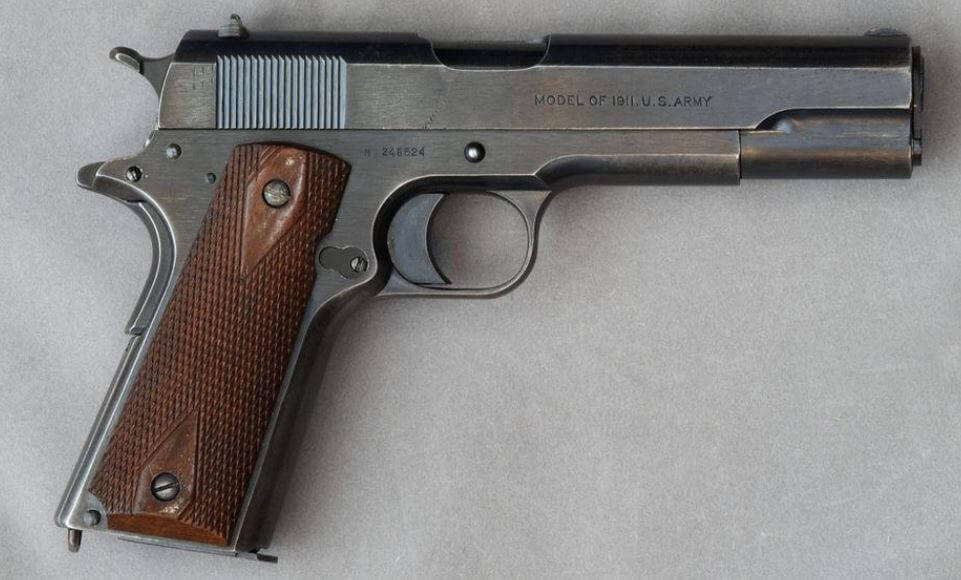
Redesigning the Pistol
After experience gained during WWI, the pistol was re-designed in 1924 to include a shorter trigger. Frame cutouts behind the trigger to help in reaching the trigger, arched mainspring housing, a larger beavertail to prevent hammer bite, a wider front sight, shorter hammer spur and simplified grip checkering.
The resulting re-designed gun was called the M1911A1. Interestingly enough, many of today’s 1911s still exhibit some of these newer features, plus other, newer modifications — the design has truly stood the test of time. It served from 1911 until 1985 as our military’s pistol and is today perhaps more popular than at any other time of its long history — at least with civilians.
If you are interested in more information about the 1911 or its chambered cartridges, I have written several articles and reviews about them. Let me just link you to some of those pieces without re-inventing the wheel. You might want to check them out because there is good information in them about this storied platform. Here you go.
- Best 1911 For The Money
- Best Budget 1911
- Colt Combat Commander
- Best 1911 in 9mm
- Colt Delta Elite
- Best .45 ACP Ammo
- Best 9mm Ammo
- SIG Sauer Scorpion 1911
Whether or not you’re a fan of the .45 is not the point. It’s been an effective cartridge for over a century. For 9mm fans out there, check my article about the best 9mm 1911s. The 9mm chambering is probably the fastest-growing segment of the current 1911 market.
Popular Articles
The Kimber Company
Before we look at the sample pistol, it’s interesting to note that Colt and Springfield Armory are not the only two modern-day manufacturers to supply 1911s to the military. Kimber has provided 1911s in the guise of what was named the Interim Close Quarter Battle (ICQB) pistol to the Marine Corps after that branch noticed that the LAPD SWAT team was pleased with their Kimber pistols.
The Marines issued a series of specifications and upgrades to bring the 1911 design into the 21st century, which Kimber addressed. This was just as Kimber was releasing their TLE/ RLII models, which incorporated several features on the list. So, Kimber guns were acquired for the Marine MEU(SOC) forces. This new 1911 was named the M45A1.
The Kimber company history is an engaging read all on its own. I detailed its roots in my article about the Kimber Micro Nine. You can also read about both the company and that pistol.
Another interesting fact is that (according to my research), I believe that Kimber sells more 1911s than any other maker. If I’m right, that says something right there about the quality of its products. Another it-blew-me-away-when-I-counted-them-up fact: according to Kimber’s website, they make no fewer than 91 different 1911 models.
Kimber Custom II 1911 Specs
Let’s look at the specs of this particular gun. Our friend Glen won it at a NWTF fundraiser dinner (hence the grip engraving) and loaned it to me to review.
| Height: | 5.25†|
| Weight: | 38 ounces with empty magazine |
| Length: | 8.7" |
| Magazine capacity: | 7 (although 8-round mags will work) |
| Recoil spring: | 16 pounds, full-length guide rod |
| Frame: | Stainless Steel, brush polish low-glare |
| Width: | 1.28" |
| Slide: | Brush polished carbon steel, black with front serrations |
| Barrel: | Stainless, match grade, 5" |
| Bushing: | Stainless, match grade |
| Sights: | Fixed low profile, 3-dot, 6.8" radius |
| Grips: | Smooth/ checkered Rosewood |
| Trigger: | Aluminum, three hole standard |
| Factory setting: | 4.0 - 5.0 pounds (2 pounds, 5 ounces as tested with Lyman gauge, an average of 10 pulls) |
Kimber Custom II 1911 Photos
Now let’s look at some up-close photos in some detail.
Here is a pic of the gun in its case with all the stuff that you get with it.
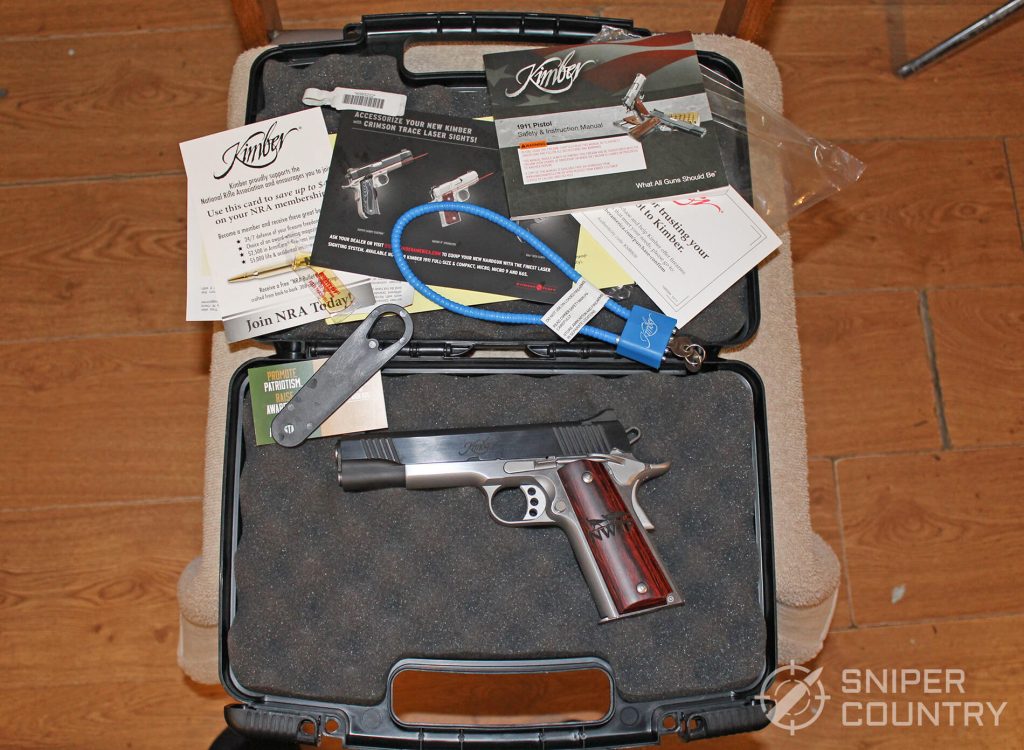
The two-tone finish really works here, with the dark slide against the brighter stainless frame. The hardwood grips just set it off. This is a nice-looking pistol.
Also, notice the bushing wrench — you’ll need it with this gun. The fit is very close, and evidently, Kimber is keeping tolerances tight. I couldn’t move the bushing without the wrench.
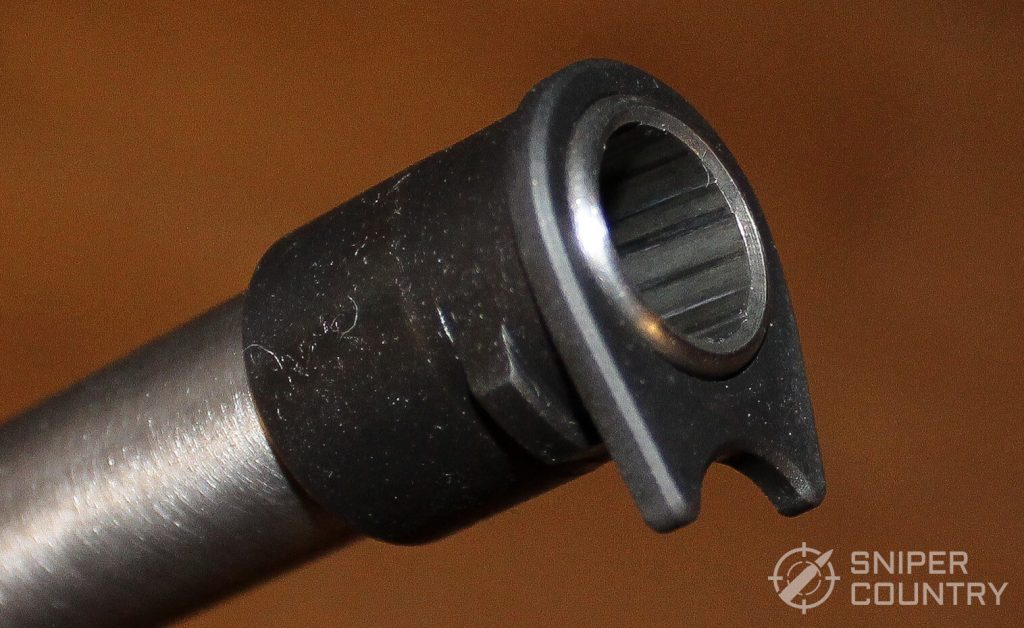
Looking at the other end of the barrel.
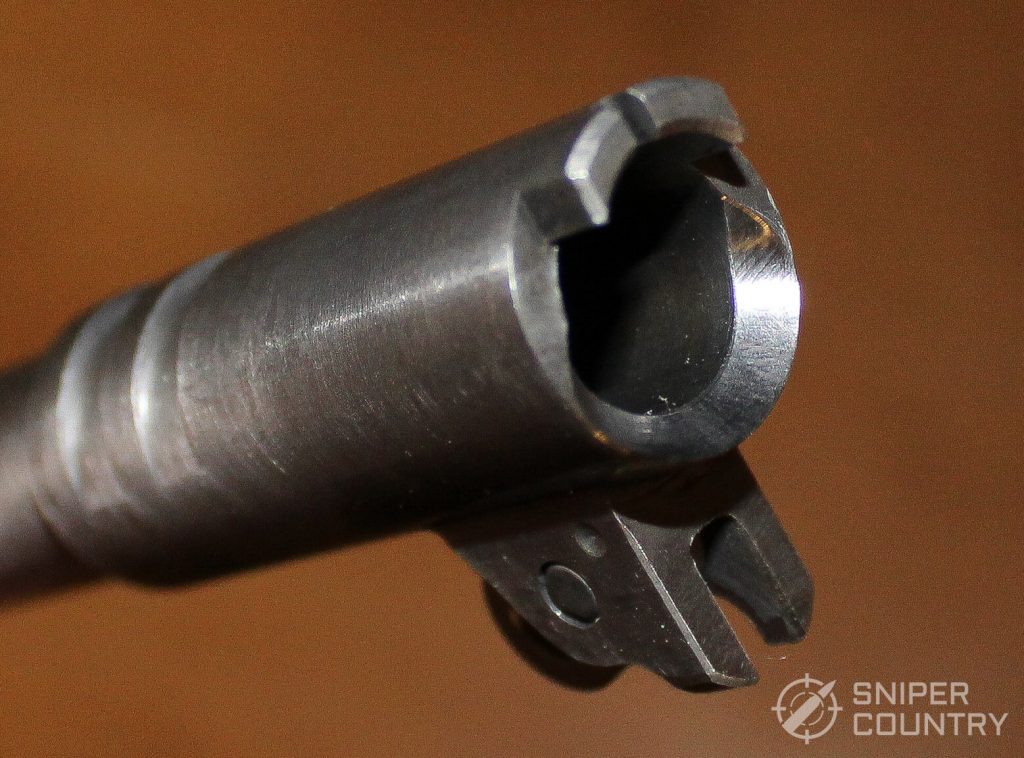
Here, we noticed a highly-polished feed ramp. Some very minor tool marks are visible, but these would not be enough to keep the gun from feeding properly. A minute or two with the appropriate-grade polishing cloth would take care of this. Again, tolerances are close.
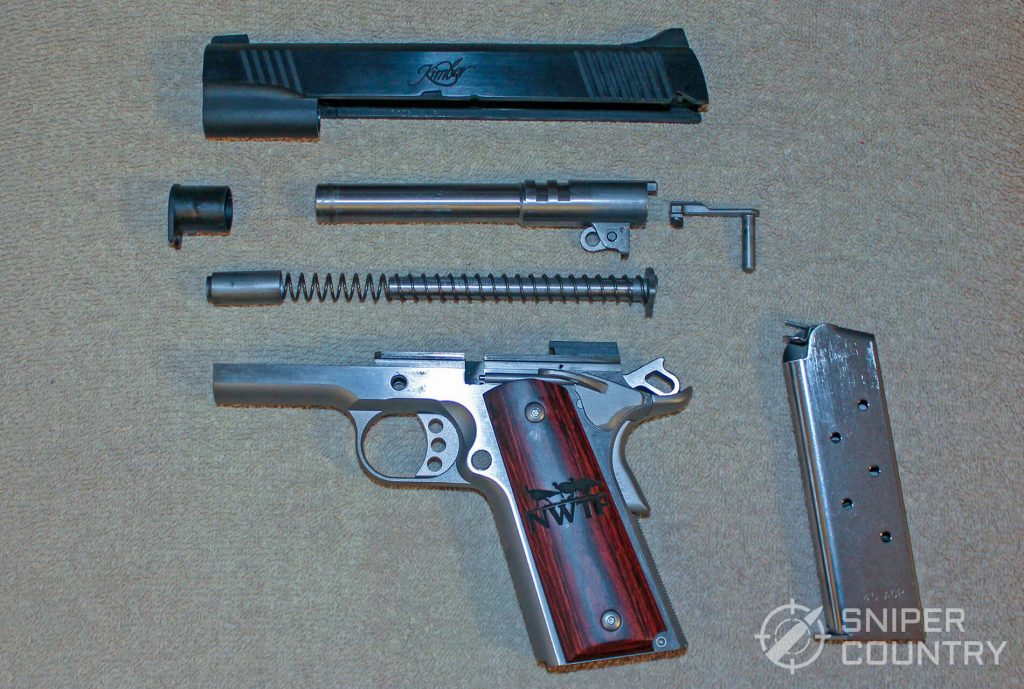
Here it is, broken down for cleaning. Looking at the frame, we see some very nice polishing.
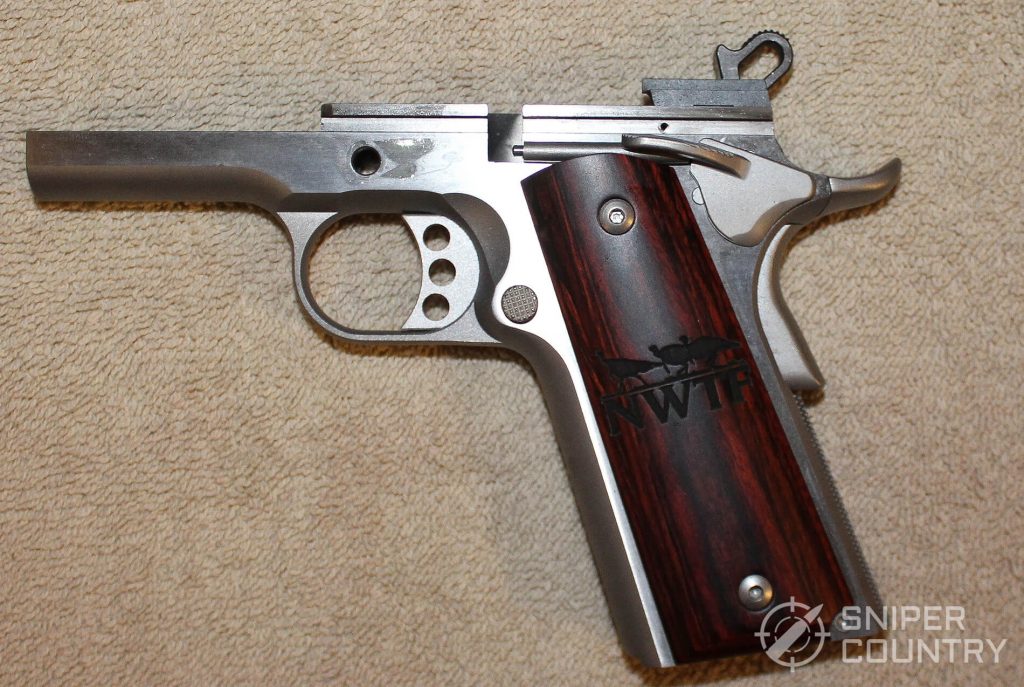
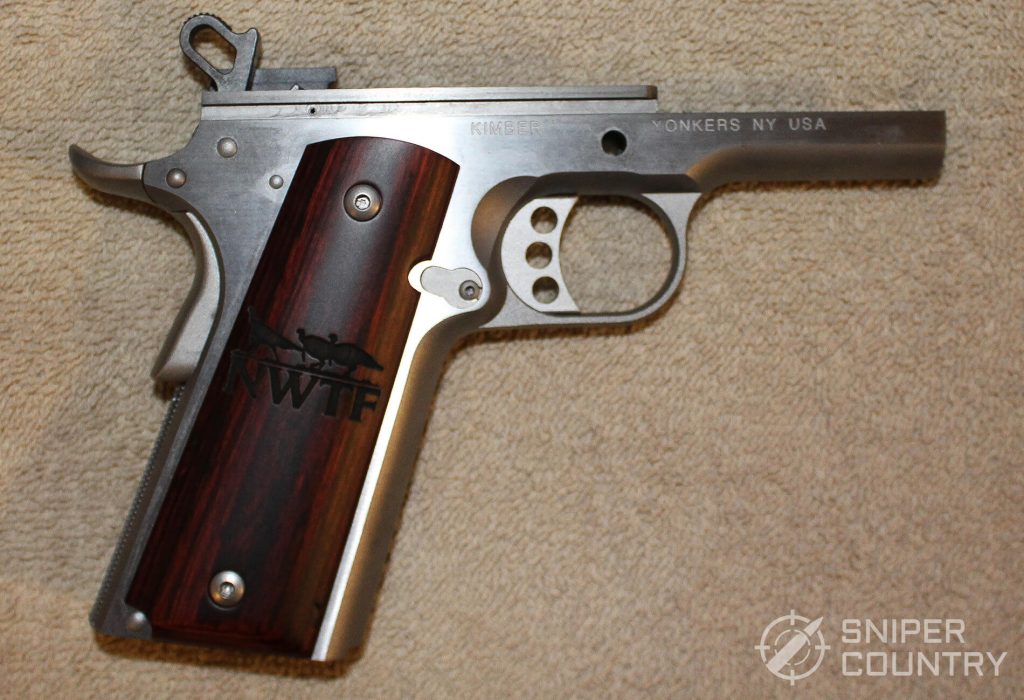
How about the slide? Here it is.


This slide has forward cocking serrations and a scalloped, lowered ejection port. The dovetailing of the sights is visible here, as well. The bluing is very even and nicely polished.
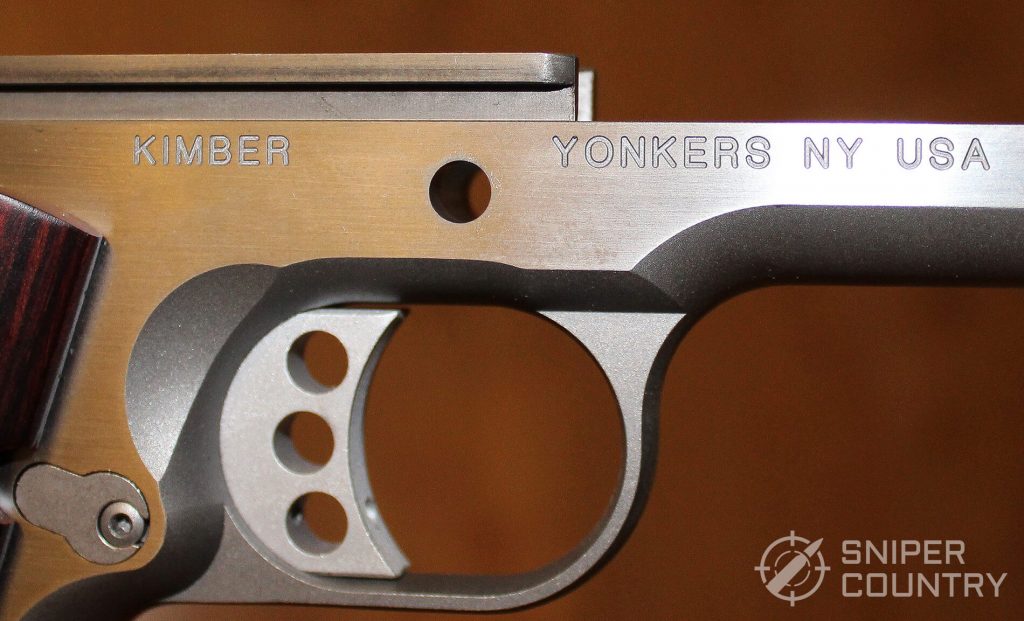
A close-up of the frame’s engraving. It’s not too much and just enough. And, the top of the frame. The large beavertail is really visible from this angle. It’s hard to see here, but the frame feed ramp is polished, as well.
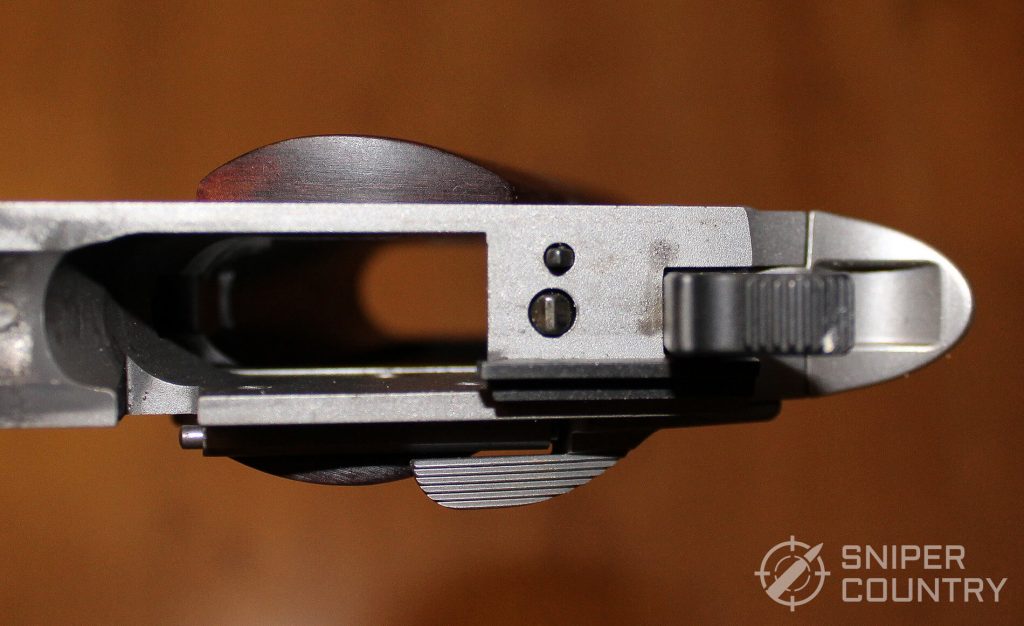

The recoil spring guide rod is full length but does not have a hole for the insertion of a paper clip or similar object in order to capture the spring. It is free, as is obvious in the photo.
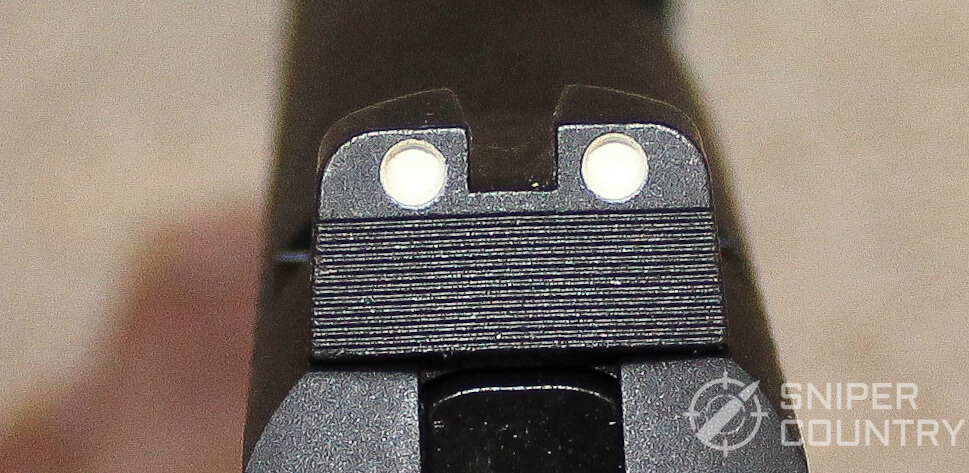
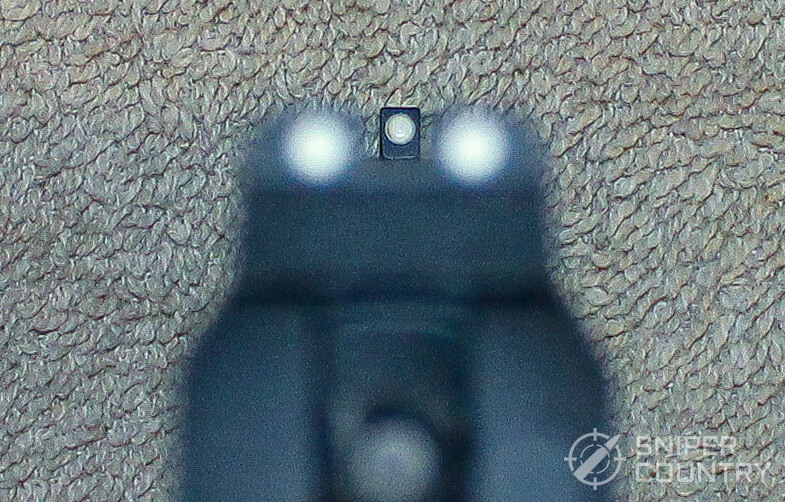
Sights, rear, and front. Sights are drift-adjustable, hence replaceable. Notice the serrations under the two rear dots that would help break up glare on a sunny day. One last point: I really liked the sight height. The taller sights were a bit easier to acquire than some I’ve used.
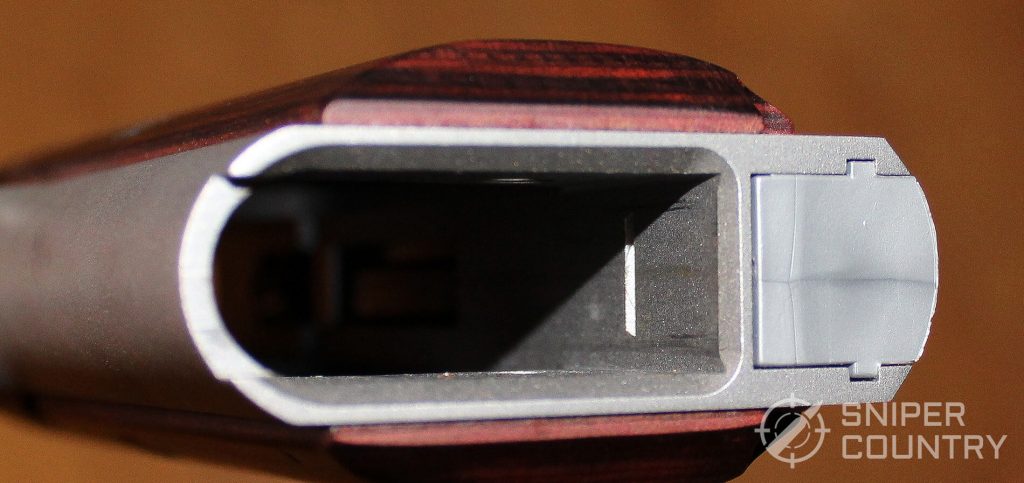
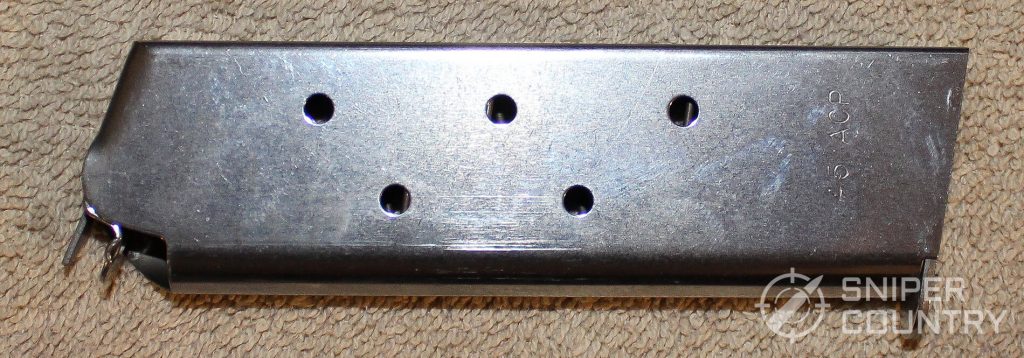
Beveled mag well and 7-round magazine. I’m not sure why they include a 7-round magazine. — an 8-rounder works very well. Matter of fact, just about any 1911 magazine should work. That opens things up in terms of carrying spare mags.
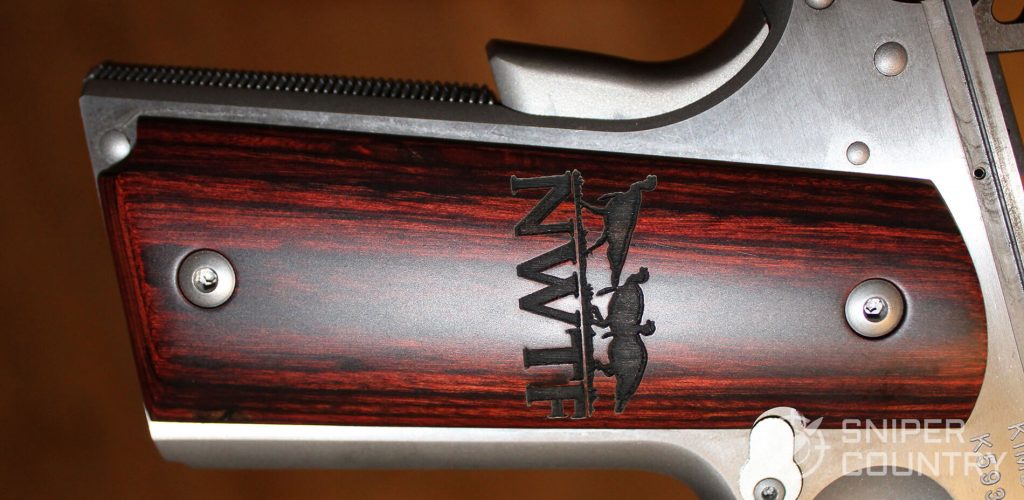
Here’s that National Wild Turkey Federation grip up close. The grips were well executed. Also, note the screws that hold the grips on. No Phillips head screws here, but Allen-key screws are used.
Lastly, take a look at the adjustable-for-overtravel trigger. The gun I shot had an average pull weight of 2 pounds, 5 ounces. You would definitely need to keep your finger off it until ready to shoot.
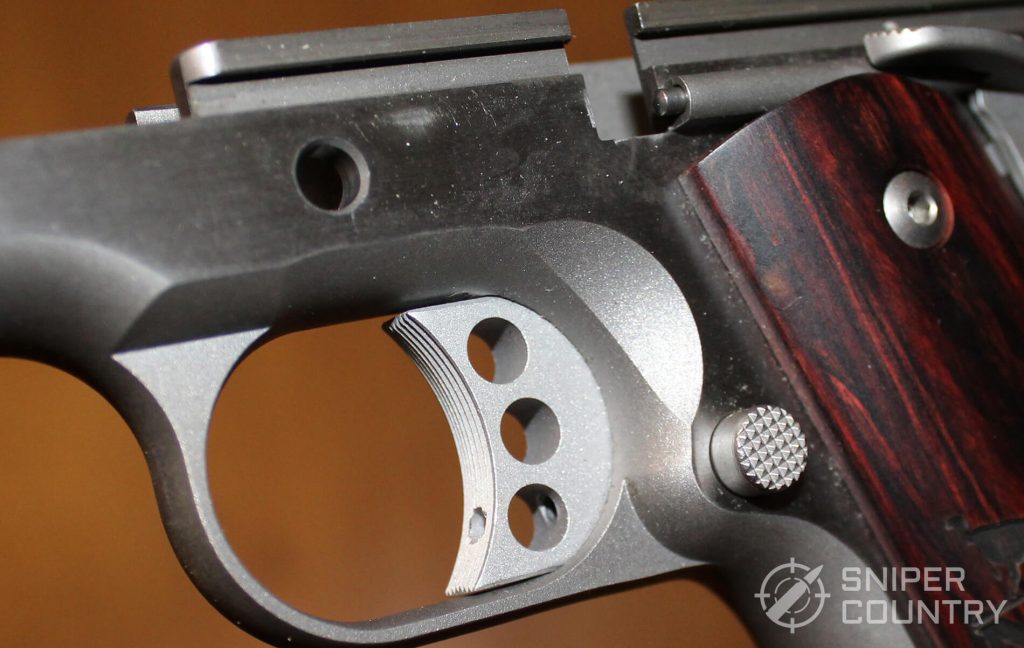
Three-hole trigger with overtravel adjustment. Note as well the A1-style relieved frame behind the trigger guard and the cut frame. It’s cut out above the plunger to avoid frame cracking.
Popular Articles
Field Stripping the Kimber Custom II 1911
Since this is a 1911 and is built fairly truly to the original, the take-down process is the same.
- Empty the gun.
- Remove the magazine.
- Swing the bushing aside and remove the recoil spring and plunger.
- Then, line up the notch on the slide with the slide release lever, push the lever from right to left and remove from the gun.
- Move the slide forward off the gun and pull the recoil spring guide rod out, and slide the barrel out of the front of the slide (move the link forward first).
That’s pretty much it. Just watch the recoil spring and keep a thumb over it. It can depart for parts unknown if left untended during its removal, or at least the plunger will.
Reassemble by reversing the procedure. The only difference I noted on reassembly was that the bushing was to be at the 9 o’clock position before the spring went in, according to the owner’s manual.
I seem to remember that most other 1911s have you move it to 9 o’clock to disassemble and 3 o’clock for reassembly, but I could be wrong. At least, that’s how the other five 1911s I’ve owned have worked.
Anyway, if you’ve taken one down before, you’re good to go on this one.
Shooting the Kimber Custom II 1911 & Impressions
I shot the gun on a typical (for us this year) winter day: gray skies, temps near freezing with a cold rainy mist falling. It’s not been the best weather around here, but it could be worse.
Anyway, I wasn’t wanting to spend hours at the shooting or cleaning benches, so I picked up a box of plain-jane 230-grain ball ammo — Magtech, by Armscor.
Armscor, based in the Philippines, makes Rock Island Armory guns and a sizeable amount of the ammo sold worldwide. They have facilities in the U.S., as well. Their ammo and guns are not fancy, but they work as advertised.
The gun’s trigger was light, very light, at two pounds, five ounces average for 10 pulls. I was wondering if this might be an aberration, a mistake, but I kept the Lyman pull gauge bar centered on the trigger and pulled straight back to get the most accurate reading.
What this tells you, if in fact the trigger pull readings are correct, is for you to keep your finger nowhere near that trigger until you want it to go bang. A trigger this light would be easy to have an accidental or negligent discharge with.
What’s the difference, you ask? An accidental discharge occurs when the gun fires when not intended. It gets dropped, falls out of a holster, or some such event occurs. The negligent variety is caused by you. You’ve had your finger in the trigger guard when it should’ve been elsewhere. I’m not a lawyer nor pretend to be. I did have a cousin who was one — but I would imagine the two are treated differently in court.
Anyway, remember to keep your finger clear until ready to shoot.
BONUS OFFER: Get your free shooting range targets to print at home!
Get your free targets to print at home!
Kimber Custom II 1911 Controls and Sights
The controls were handy and worked well. They would be even handier if they were replicated on the right side of the gun since I’m left-handed. However, your average, B-flat 1911 is not going to have that setup. I’m used to it.
Also, the safety and the slide release were decently-sized and had just enough serrations/ texturing to accord a firm, non-slip finger purchase. As can be seen in the photo directly above, the magazine release boasted some pretty bodacious checkering. So no slipping off that one.
The sights were bright, for non-night sights. The dots were easy to acquire. It seems that every handgun I pick up shoots to the left — something about my grip and dominant-eye-weak-eye, I guess. This one was no different. At least (if it were mine), that could be easily addressed by pushing the rear sight to the right, or the front sight to the left. (Quick sight adjustment note — move the rear sight in the direction you want the group to move, and move the front sight the other way). Either way, you could fix it quickly.
Below is a target I shot. This is not my best work and I’m almost ashamed to include it here, but I wanted to prove, yes, I did shoot this thing even in the beastly weather we’ve had. At least the shots were on the paper.
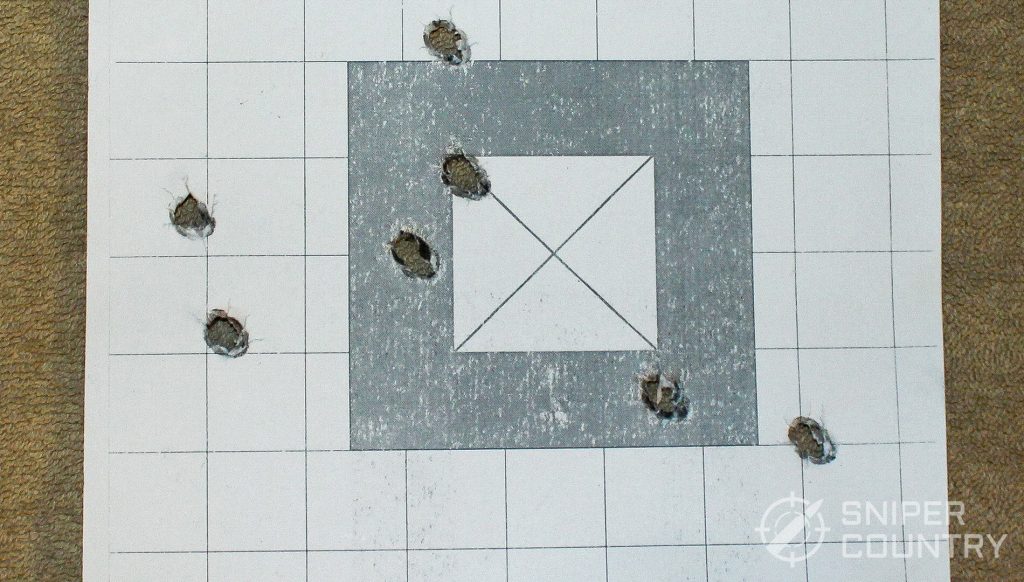
Each square is an inch. I was right at 25 yards when I shot this, and used a six o’clock hold, as I do for guns that are not defense-oriented. There, I use a center hold. I put the front sight just under the center of the big black square.
Then, I dumped the magazine fairly quickly and achieved, if not a group, at least a pattern. The gun was capable of far greater accuracy than I was that day. I tend to shoot better when I don’t have freezing drizzle coming down on my glasses, but that’s an excuse.
Anyway, I tried my tried and true handload of a 200-grain SWC over 5.3 grains of HP38/231, but it wasn’t any better. You’d think with the excellent trigger this gun has, I’d have done better than this but it was not to be.
Every Kimber I’ve ever shot has shown itself to be an accurate weapon, and this one would be no exception if I had done my part. Due to the nature of my having possession of the gun for just a short while, I had to settle for getting what I could. Anyway, as I keep telling myself, it ain’t about me. It’s about the gun. This is one honey of a 1911.
The stainless frame contrasts nicely with the blued slide, and the controls match very well. Here it is again, from the photo above.
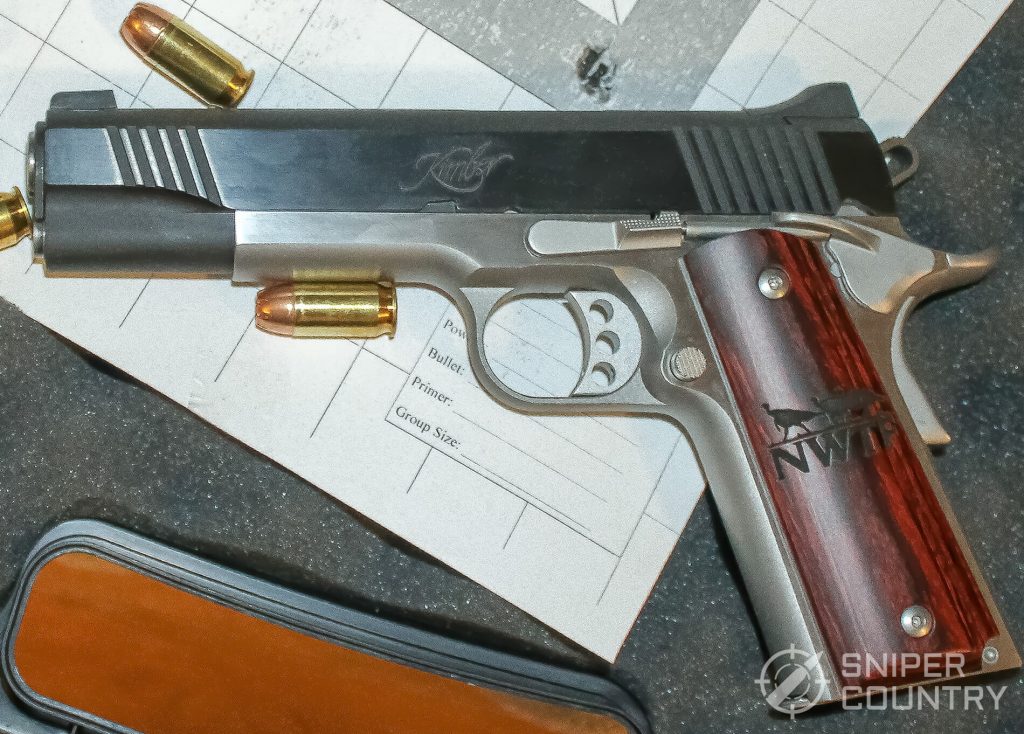
The NWTF-engraved grips just sort of set it off, apart from other plain factory models. The hard case with all its extra cargo adds to the panache. Kimber does not skimp on the extras. Even though this gun had been shot and handled a fair amount, it was in great shape and still exhibited the new factor.
Another thing that really impressed me, which helped convince me to make the close-tolerance statements above, was the fit of the slide release with the plunger.
Usually (at least in my experience), pushing a slide release into a 1911’s frame against the plunger spring’s resistance is not all that hard, but this gun had a plunger spring on steroids. I could get it in, but had to really try to do so. It was a pretty stiff spring.
I don’t know whether or not I could find out what tension that little spring is built to, but it did its job admirably. That slide release and thumb safety will not move until you tell them to, to be sure. Again, this is just another example of how tightly this gun is built, and it helps to illustrate that point.
Kimber Custom II Problems
You can’t go wrong with the Kimber custom II for self-defense. For the low cost, you receive a dependable and accurate handgun. However, there are several problems with it that you should be aware of before buying.
- Hard recoil. The custom II’s recoil may feel stronger than those of its counterparts. This is because the recoil springs are stiff. The variety and quality of ammunition are also crucial factors. Because of this, PMC rounds are suggested and avoid using MagTech.
- Failure to eject. It’s important that the spent shell casing leave the chamber after each shot. Failed ejection occurs when the casing becomes caught within. The problem might be with the gun itself, the magazine, the ammunition, or any combination of these. Sometimes bullets have defects, so you might try using another ammo. This is typically the result of using low-quality ammunition.
- Lack of frontal handle serrations. This gun’s front strap of the grip is quite smooth, which might cause issues. The smooth part really hinders your control over the recoil.
Wrap Up: Is Kimber Custom II a Good Gun?
If you are looking for a mid-priced, well-built 1911 made here in the U.S., check out the Kimber. Even if you are not a fan of the two-tone finish, or may want an ambidextrous safety or some other feature(s), they most likely will have one for you. Check their website for all the models and variations they provide. Hopefully, you’ll find that one of their 91 models melts your butter.
If you are looking for a solidly-built, no-nonsense 1911, check this one out. If you own one of these, please leave a comment below as to how it’s working out for you. As always, shoot straight and be safe.





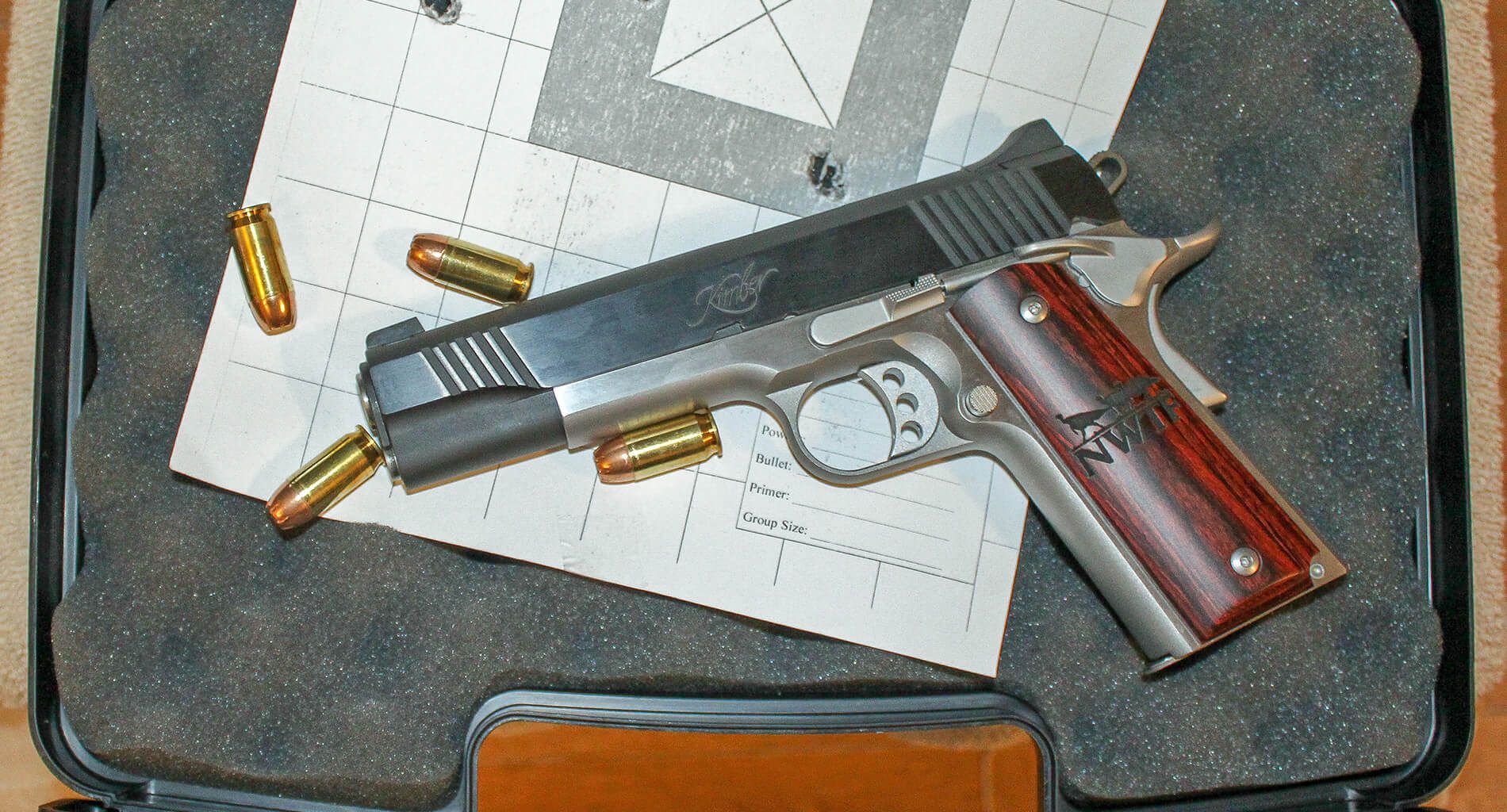
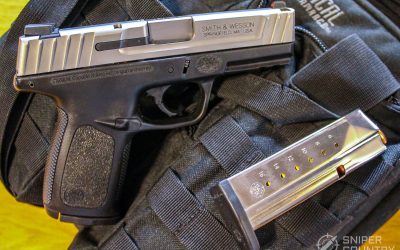

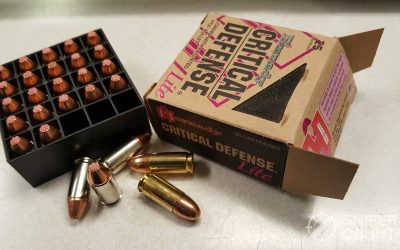
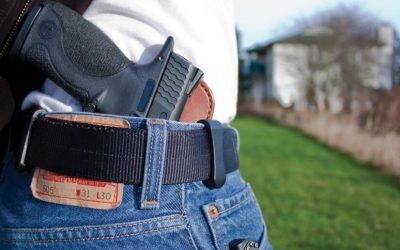
![9mm Glock Models [Ultimate Guide]](https://www.snipercountry.com/wp-content/uploads/2018/10/Glock-17-vs-Glock-19-vs-Glock-26-vs-Glock-41-vs-Glock-43-WM-400x250.jpg)
![Handgun Caliber Chart [2025 Ultimate Guide]](https://www.snipercountry.com/wp-content/uploads/2018/10/Handgun-Caliber-Comparison-400x250.jpg)
![Rifle Calibers [Ultimate Guide]](https://www.snipercountry.com/wp-content/uploads/2018/12/Header-1900-400x250.jpg)

